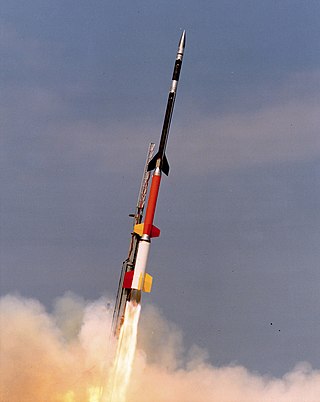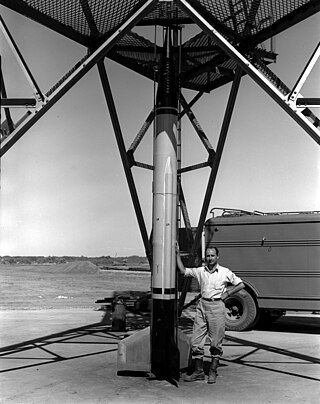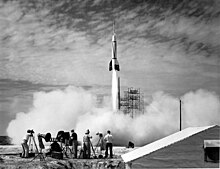
The Jupiter-C was an American research and development vehicle developed from the Jupiter-A. Jupiter-C was used for three uncrewed sub-orbital spaceflights in 1956 and 1957 to test re-entry nosecones that were later to be deployed on the more advanced PGM-19 Jupiter mobile missile. The recovered nosecone was displayed in the Oval Office as part of President Dwight D. Eisenhower's televised speech on November 7, 1957.

The Aerobee rocket was one of the United States' most produced and productive sounding rockets. Developed by the Aerojet Corporation, the Aerobee was designed to combine the altitude and launching capability of the V-2 with the cost effectiveness and mass production of the WAC Corporal. More than 1000 Aerobees were launched between 1947 and 1985, returning vast amounts of astronomical, physical, aeronomical, and biomedical data.

A sounding rocket or rocketsonde, sometimes called a research rocket or a suborbital rocket, is an instrument-carrying rocket designed to take measurements and perform scientific experiments during its sub-orbital flight. The rockets are used to launch instruments from 48 to 145 km above the surface of the Earth, the altitude generally between weather balloons and satellites; the maximum altitude for balloons is about 40 km and the minimum for satellites is approximately 121 km. Certain sounding rockets have an apogee between 1,000 and 1,500 km, such as the Black Brant X and XII, which is the maximum apogee of their class. For certain purposes Sounding Rockets may be flown to altitudes as high as 3,000 kilometers to allow observing times of around 40 minutes to provide geophysical observations of the magnetosphere, ionosphere, thermosphere and mesosphere. Sounding rockets have been used for the examination of atmospheric nuclear tests by revealing the passage of the shock wave through the atmosphere. In more recent times Sounding Rockets have been used for other nuclear weapons research. Sounding rockets often use military surplus rocket motors. NASA routinely flies the Terrier Mk 70 boosted Improved Orion, lifting 270–450-kg (600–1,000-pound) payloads into the exoatmospheric region between 97 and 201 km.

Cape Canaveral Space Force Station (CCSFS) is an installation of the United States Space Force's Space Launch Delta 45, located on Cape Canaveral in Brevard County, Florida.

Saturn-Apollo 3 (SA-3) was the third flight of the Saturn I launch vehicle, the second flight of Project Highwater, and part of the American Apollo program. The rocket was launched on November 16, 1962, from Cape Canaveral, Florida.

A sub-orbital spaceflight is a spaceflight in which the spacecraft reaches outer space, but its trajectory intersects the surface of the gravitating body from which it was launched. Hence, it will not complete one orbital revolution, will not become an artificial satellite nor will it reach escape velocity.

Viking was a series of twelve sounding rockets designed and built by the Glenn L. Martin Company under the direction of the U.S. Naval Research Laboratory (NRL). Designed to supersede the German V-2 as a research vehicle, the Viking was the most advanced large, liquid-fueled rocket developed in the United States in the late 1940s, providing much engineering experience while returning valuable scientific data from the edge of space between 1949 and 1955. Viking 4, launched in 1950, was the first sounding rocket to be launched from the deck of a ship.

The North American SM-64 Navaho was a supersonic intercontinental cruise missile project built by North American Aviation (NAA). The final design was capable of delivering a nuclear weapon to the USSR from bases within the US, while cruising at Mach 3 at 60,000 feet (18,000 m) altitude. The missile's name is an acronym for North American Vehicle using Alcohol and Hydrogen peroxide and Oxygen.

The WAC Corporal was the first sounding rocket developed in the United States and the first vehicle to achieve hypersonic speeds. It was an offshoot of the Corporal program, that was started by a partnership between the United States Army Ordnance Corps and the California Institute of Technology in June 1944 with the ultimate goal of developing a military ballistic missile.

Arcas was the designation of an American sounding rocket, developed by the Atlantic Research Corp., Alexandria, Va.

The RTV-A-2 Hiroc was a product of the United States' first effort to develop an intercontinental ballistic missile (ICBM). The project was named MX-774. The project was canceled in 1947, but leftover funds were used to build and launch three of the planned 10 research vehicles designated RTV-A-2. The design included several innovations; the gimbaled thrust chambers provided guidance control, the internal gas pressure was used to support the airframe and the nose cap was separable. All of these concepts were later used on the Atlas missile and the first two on the Viking rocket. Also developed as part of MX-774 was the Azusa guidance system which was not used on the Hiroc missile but did contribute to the Atlas missile as well as many other early guided missiles launched from Cape Canveral.

Spaceflight as a practical endeavor began during World War II with the development of operational liquid-fueled rockets. Beginning life as a weapon, the V-2 was pressed into peaceful service after the war at the United States' White Sands Missile Range as well as the Soviet Union's Kapustin Yar. This led to a flourishing of missile designs setting the stage for the exploration of space. The small American WAC Corporal rocket was evolved into the Aerobee, a much more powerful sounding rocket. Exploration of space began in earnest in 1947 with the flight of the first Aerobee, 46 of which had flown by the end of 1950. These and other rockets, both Soviet and American, returned the first direct data on air density, temperature, charged particles and magnetic fields in the Earth's upper atmosphere.

Project Hermes was a missile research program run by the Ordnance Corps of the United States Army from November 15, 1944, to December 31, 1954, in response to Germany's rocket attacks in Europe during World War II. The program was to determine the missile needs of army field forces. A research and development partnership between the Ordnance Corps and General Electric started November 20, 1944 and resulted in the "development of long-range missiles that could be used against both ground targets and high-altitude aircraft."

Vanguard TV-3BU, also called Vanguard Test Vehicle-Three Backup, was the second flight of the American Vanguard rocket. An unsuccessful attempt to place an unnamed satellite, Vanguard 1B, into orbit, the rocket was launched on 5 February 1958. It was launched from LC-18A at the Cape Canaveral Air Force Station. Fifty-seven seconds after launch, control of the vehicle was lost, and it failed to achieve orbit. At 57 seconds, the booster suddenly pitched down. The skinny second stage broke in half from aerodynamic stress, causing the Vanguard to tumble end-over-end before a range safety officer sent the destruct command. The cause of the failure was attributed to a spurious guidance signal that caused the first stage to perform unintended pitch maneuvers. Vanguard TV-3BU only reached an altitude of 6.1 km (3.8 mi), the goal was 3,840 km (2,390 mi).

German V-2 rockets captured by the United States Army at the end of World War II were used as sounding rockets to carry scientific instruments into the Earth's upper atmosphere, and into sub-orbital space, at White Sands Missile Range (WSMR) for a program of atmospheric and solar investigation through the late 1940s. Rocket trajectory was intended to carry the rocket about 100 miles (160 km) high and 30 miles (48 km) horizontally from WSMR Launch Complex 33. Impact velocity of returning rockets was reduced by inducing structural failure of the rocket airframe upon atmospheric re-entry. More durable recordings and instruments might be recovered from the rockets after ground impact, but telemetry was developed to transmit and record instrument readings during flight.

The Falcon 9 first-stage landing tests were a series of controlled-descent flight tests conducted by SpaceX between 2013 and 2016. Since 2017, the first stage of Falcon 9 rockets are routinely landed if the performance requirements of the launch allow.

Vanguard TV-0, also called Vanguard Test Vehicle-Zero, was the first sub-orbital test flight of a Viking rocket as part of the Project Vanguard.

Vanguard TV-1, also called Vanguard Test Vehicle-One, was the second sub-orbital test flight of a Vanguard rocket as part of the Project Vanguard. Vanguard TV-1 followed the successful launch of Vanguard TV-0 a one-stage rocket launched in December 1956.

Vanguard TV-2, also called Vanguard Test Vehicle-Two, was the third suborbital test flight of a Vanguard rocket as part of Project Vanguard. Successful TV-2 followed the successful launch of Vanguard TV-0 a one-stage rocket launched in December 1956 and Vanguard TV-1 a two-stage rocket launched in May 1957.

Vanguard SLV-3, also called Vanguard Satellite Launch Vehicle-3 hoped to be the second successful flight of the American Vanguard rocket following successful Vanguard 1 satellite on rocket Vanguard TV-4.

























